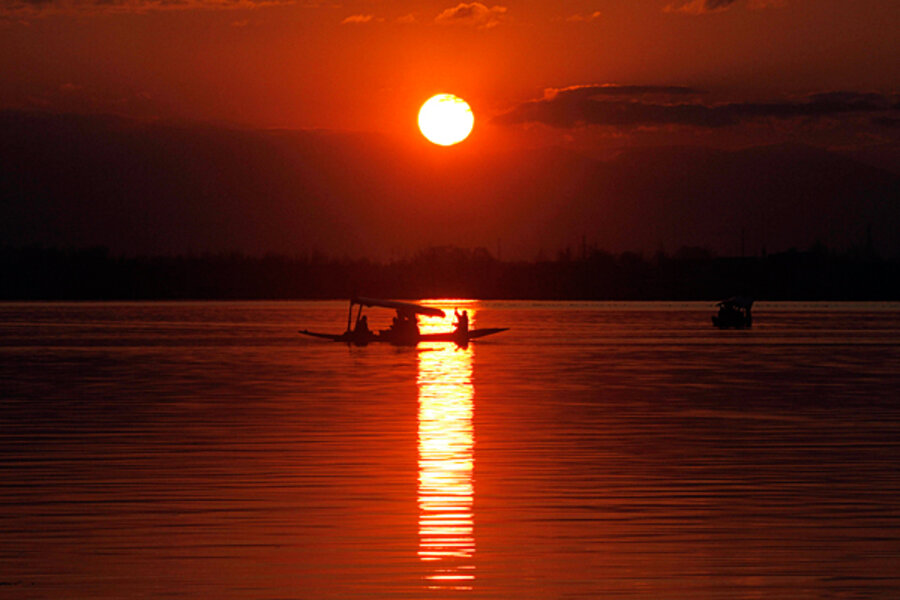Climate change sends India's apple farmers up the Himalayas
Loading...
| Himachal Pradesh, India
The hills of Thanedar-Kotgarh lie four hours from Shimla, the capital of this Himalayan state in northwest India. This is where Samuel Evans Stokes, a Quaker missionary from Philadelphia, first planted American Red Delicious apple trees in 1916, convinced that these hills were ideal for apple growing – and that local farmers getting by on barley and potatoes would prosper with the fruit.
Within a few decades, locals took to apple farming and Indians took to the sweet and juicy Red Delicious. Apple cultivation expanded through the state, growing from 400-odd hectares in the 1950s to more than 100,000 hectares in 2012 – a horticultural revolution that raised incomes in India’s least urbanized state.
But the climate that Mr. Stokes saw may be disappearing. The most visible change for farmers has been in snowfall, which shapes the apple crop. Snowfall has reduced by 36 millimeters annually in this region since the late 1980s, according to one study.
“When I was young, in the ‘60s, we would have a white Christmas every year,” says Prakash Thakur, a local orchardist. “Now we rarely see that. Snow doesn’t come before January, sometimes February or March.”
This year has been unusually good so far, with relatively early snow and the best winter in two decades. But Kushal Chauhan, a third-generation farmer and small orchardist, can't relax yet.
Last April, unexpected hail robbed him of a fifth of his crop. Two years before that, a May drought took its toll.
“We’ll have to see what happens in spring,” he says.
Almost 100 years after an American missionary seeded an apple-growing revolution here, local farmers are facing new challenges – aging orchards, growing competition from imports, and, perhaps most worrying, erratic weather and climatic shifts including warmer winters that are pushing apple cultivation to higher elevations.
“There is a disturbance in the cycle,” says orchardist Sohan Thakur. “What was normal [weather], appropriate for apples, is not there.”
Rising temperatures
A recent study found that because of warmer temperatures and reduced snowfall, apple-growing areas in low-altitude areas like Solan reduced by as much as 77 percent between 1981 and 2007. In the same period, apple farming took off in the higher-altitude areas of Kinnaur and Lahaul and Spiti, which were earlier considered too cold and dry.
The study also found orchards in mid-altitude areas like Thanedar expanding, though earlier research had found a decrease. That may be because farmers there are switching to hardier varieties, says Kartar Verma, study author and the head of the environmental science department at the YS Parmar University of Horticulture and Forestry, in Solan, India.
Lower-altitude apple farmers can’t adapt in the same way, he says, because they lie in a transitional climatic zone. “These areas are turning from subtemperate into subtropical,” says Mr. Verma.
The Himalayan region is warming faster than most places in the world, especially in the past three decades, says Kamaljit Bawa, distinguished professor of biology at University of Massachusetts. [Editor's note: The original version of this sentence misidentified Professor Bawa's university]
Mean surface temperature in the Himalayas rose by 1.5 degrees Celsius from 1982 to 2006, according to a 2012 study by Harvard researchers, compared with a 0.6 degree C rise in the global mean from 1975 to 2005.
Winter is warming faster than summer. Some areas here saw maximum mean winter temperatures go up by as much as 3.4 degrees C from the 1980s. The 2012 study also found spring advancing – though there is significant variation across the Himalayas, which run from Pakistan in the west to Bhutan in the east.
Ecological changes are already afoot. Many Himalayan glaciers are shrinking, though at varying rates. Increased snow and glacier melt could have fallouts on water supply – the Himalayas feed the subcontinent’s big rivers – and power. Increased sedimentation could affect some of the 25 hydroelectric dam projects underway in Himachal Pradesh to supply power to Delhi and the plains.
One study shows the alpine tree line in the northwest region is retreating upland. Rhododendrons have invaded the alpine meadows in the same area.
“We’re seeing pests in places not seen before, including mosquitoes,” says Mr. Bawa.
Warming is not the only reason for some of these changes, he notes. “Land use and other changes are also drivers.”
What change in snowfall means
For local apple farmers, the change in snowfall is especially critical because snow helps provide the moist chill that apple trees need during dormancy. Traditional Red Delicious apples require 1,200 to 1,400 “chilling hours” of below 7 degrees C. Late, reduced snowfall means fewer chilling hours, raising the risk of a poor crop.
Spring weather has also become unpredictable, says Vijay Thakur, associate director at the Regional Horticultural Research Station in Mashobra. “The blossoming period in April should have little rain and moderate temperatures. But we’re seeing temperatures swinging” and unseasonal rain, he says. Some studies find winter rainfall declining and monsoon rain increasing in this area.
Most puzzling for Vijay Thakur is the increase in hailstorms. It used to hail only in a few locations. “Now, there’s almost no area where it doesn’t hail, and the storms last for several hours,” he says.
Erratic weather has led to large year-to-year fluctuations in production. But non-climatic factors are to blame for low productivity. Outdated rootstocks, old trees, deteriorating soil and poor management – or absentee management, since many farmers’ children now live in the city – have kept yields stagnant since the 1980s.
The apple yield here is between four and seven apples per hectare. India’s overall yield is higher, boosted by Kashmir’s higher production, but seven and 10 apples a hectare is still well below the average yield of 16 in China and 30 in the United States.
Poor transport and cold storage facilities also push up post-harvest losses and bring down revenues. In 2010, a record harvest led to a glut in the market, crashing prices. In the past few years, six new cold storage facilities have been set up in the region, but more are needed, says orchardist Sohan Thakur.
Inadequate cold storage is why people can still buy last year’s American apples in Indian cities this month but not Himachal ones.
Increased competition
Increased competition from Chinese and American apples means that farmers here must adapt to more than climatic changes.
“As long as the economy was closed, we didn’t feel the pressure,” says Hari Chand Roach, a wealthy orchardist. India’s economy was liberalized in the early 1990s, and fruit imports have since shot up as incomes have risen – and despite higher prices from import duties.
“Once those duties go, smaller farmers will be crushed unless they can adapt,” Mr. Chand Roach says.
Most farms here are small, with holdings of less than two hectares – Chauhan owns a little over one hectare. They can’t afford to revamp their orchards at one go, or without help, notes Onkar Shad, president of the leftist Himachal Pradesh Apple Growers Association. New high-yield, climate-hardy breeds also require more water – a challenge in a country that relies largely on rain for irrigation.
Some measures are under way. In March, the government raised the subsidy on nets used to protect trees from hailstorms up to 80 percent. A new climate-change plan proposes to open more tourist facilities at higher, now accessible altitudes, promote crop diversification, and help farmers plant hardier apple stocks, including a more productive Delicious variety called Super Chief.
Meanwhile, bigger farms are already importing other breeds. Chand Roach has planted Fuji and Gala apples, favored by Chinese farmers, which require fewer chilling hours. Prakash Thakur is trying Italian varieties. “We have to move on from Delicious,” he says.
Others, especially at lower elevations, are switching to almonds, pomegranates, and cherries. Chauhan, too, has planted green almond trees in a corner of his orchard. “We can’t rely on apples alone anymore,” he says.






